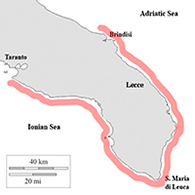Phylum: Mollusca - Order: Littorinimorpha Golikov & Starobogatov, 1975
Family: Rissoidae Gray, 1847
Alvania hallgassi Amati & Oliverio, 1985
|
Alvania hallgassi Amati & Oliverio, 1985 è specie comune nel Salento, abbondantemente presente sia nel Mar Ionio che nel Mar Adriatico meridionale, d’altronde è stata descritta su esemplari di Otranto. Certamente il Salento con la sua notevole variabilità geo-morfologica che interagisce fortemente con lo sviluppo degli ambienti marini circostanti è la località del Mediterraneo più adatta ad osservare questa specie e la sua notevole variabilità. Nelle nostre ricerche abbiamo indagato approfonditamente due località dove abbiamo trovato questa specie particolarmente abbondante: Gallipoli e Otranto (Lecce, Italy). Come potrà essere osservato nelle foto che seguono, la maggiore variabilità tra gli esemplari si manifesta al variare della profondità. In particolare gli esemplari provenienti da batimetrie di circa 60 m di profondità, ottenute da detriti raccolti a contatto con biocenosi coralligene con la presenza di Alcyonacei (Savaglia savalia, Paramuricea clavata e altri Gorgonacei) sono di maggiori dimensioni, frequentemente superano i 3 mm di altezza e con 3,6-4 giri di teleoconca. Abbiamo pensato alla possibilità che almeno questi ultimi esemplari potessero appartenere alla specie Alvania dalmatica Buzzurro et Prkic, 2007 ma siamo consapevoli che queste due specie o tre se includiamo A. dianiensis Oliverio, 1988 richiedono un esame di tipo genetico per essere separate. Alvania hallgassi Amati & Oliverio, 1985 is a common species in Salento, abundantly present in both the Ionian Sea and the southern Adriatic Sea, moreover it has been described on specimens from Otranto. Certainly Salento, with its notable geo-morphological variability which interacts strongly with the development of the surrounding marine environments, is the most suitable location in the Mediterranean to observe this species and its notable variability. In our research we investigated in depth two locations where we found this particularly abundant species: Gallipoli and Otranto (Lecce, Italy). As can be seen in the following photos, the greatest variability between specimens occurs as the depth varies. In particular, the specimens coming from bathymetries of approximately 60 m depth, obtained from debris collected in contact with coral biocoenoses with the presence of Alcyonaceans (Savaglia savalia, Paramuricea clavata and other Gorgonaceae) are larger, frequently exceeding 3 mm in height and with 3.6-4 turns of the teleoconch. We thought about the possibility that at least these last specimens could belong to the species Alvania dalmatica Buzzurro et Prkic, 2007 but we are aware that these two species or three if we include A. dianiensis Oliverio, 1988 require a genetic examination to be separated.
|
||||||
|---|---|---|---|---|---|---|---|
Otranto (Lecce, Italy) Ionian and South Adriatic Sea. 20 to 40 m of depth. Questo a destra riteniamo sia il morfotipo che comunemente può essere incontrato nei detriti provenienti da queste batimetrie. Come abbiamo detto nelle premesse, a maggiori profondità, nelle stesse località, è possibile incontrare esemplari morfologicamente differenti che al momento riteniamo possano appartenere alla stessa specie. We believe this on the right is the morphotype that can commonly be encountered in debris from these bathymetries. As we said in the introduction, at greater depths, in the same locations, it is possible to encounter morphologically different specimens which at the moment we believe may belong to the same species. |
 |
||||||
| S. Cesarea Terme (Lecce, Italy), Ionian Sea, 41 m of depth. |  |
||||||
Gallipoli (Lecce, Italy) Ionian Sea 60 m deep.
Giù seguono tre foto al SEM dello stesso esemplare. Below follow three SEM photos of the same specimen. |
 |
||||||
Gallipoli (Lecce, Italy) Ionian Sea, 60m deep.
|
 |
||||||
| Gallipoli (Lecce, Italy) Ionian Sea, 60m deep. |  |
||||||
| Gallipoli (Lecce, Italy) Ionian Sea, 60m deep. |  |
||||||
Otranto - Orte (Lecce, Italy) South Adriatic Sea, 62 m deep.
Giù seguono tre foto al SEM dello stesso esemplare. Below follow three SEM photos of the same specimen.
|
 |
||||||
| Otranto - Orte (Lecce, Italy) South Adriatic Sea, 62 m deep. | .jpg) |
||||||
| Otranto - Orte (Lecce, Italy) South Adriatic Sea, 62 m deep. |  |
||||||
| Otranto - Orte (Lecce, Italy) South Adriatic Sea, 62 m deep. |  |
||||||
Otranto - Remite (Lecce, Italy) South Adriatic Sea, 37 m deep.
Giù seguono tre foto al SEM dello stesso esemplare. Below follow three SEM photos of the same specimen. |
 |
||||||
| Otranto - Remite (Lecce, Italy) South Adriatic Sea, 37 m deep. |  |
||||||
| Otranto - Remite (Lecce, Italy) South Adriatic Sea, 37 m deep. |  |
||||||
| Otranto - Remite (Lecce, Italy) South Adriatic Sea, 37 m deep. |  |
||||||
Otranto - Orte (Lecce, Italy) South Adriatic Sea, 62 m deep. All'interno di sedimenti raccolti in ambiente coralligeno alla profondità di 62m, in associazione ad esemplari di Paramuricea clavata (Risso, 1826) |
 |
||||||
| Otranto - Orte (Lecce, Italy) South Adriatic Sea, 62 m deep. |  |
||||||
Gallipoli (Lecce, Italy) Ionian Sea 60 m deep. All'interno di sedimenti raccolti in ambiente coralligeno alla profondità di 60m, in associazione ad esemplari di Savalia savaglia (Bertoloni, 1819). |
 |
||||||
Bibliography Aamati B. & Oliverio M. 1985. Alvania (Alvaniella) hallgassi sp. n. (Gastropoda, Prosobranchia). Notiz. CISMA - 1984 - VI (l-2): 28-34 (1985) Romani L. 2014. Alvania dalmatica Buzzurro et Prkic, 2007 (Gastropoda Rissoidae): range extension, shell variability, habitat and relationships with A. hallgassi Amati et Oliverio, 1985. Biodiversity Journal, 2014, 5 (4): 509–514 Trono D., Macrì G. & Renda W. 2023. The latest but not the last: Checklist of the Molluscan fauna of the Salento coast (Apulia, Italy). Boll. Malacol., 59: 59-105 (1, 05/04/2023) https://doi.org/10.53559/Boll Malacol. 2022.19. |
|||||||

